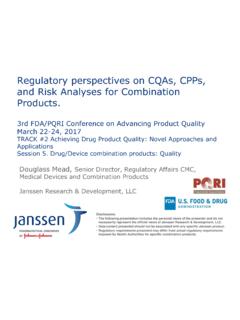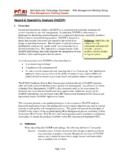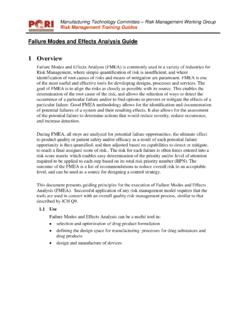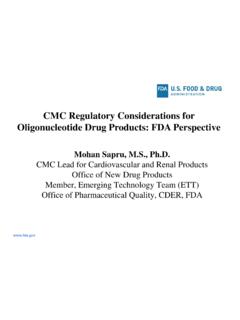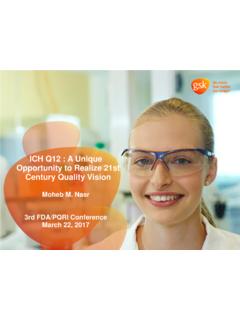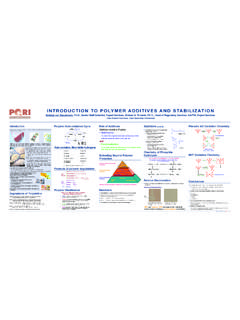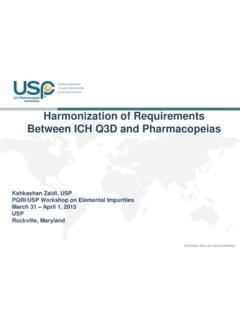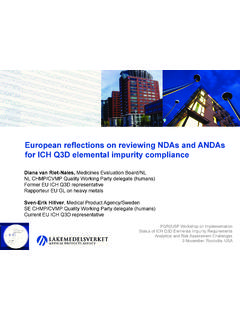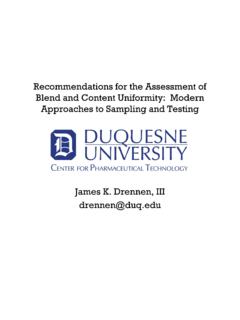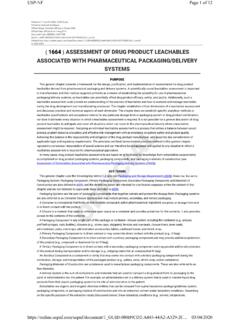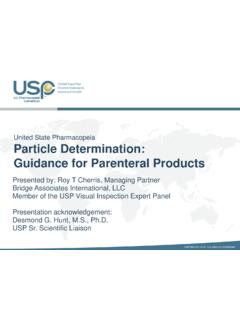Transcription of Safety Thresholds and Best Demonstrated Practices for ...
1 PQRI Confidential 1 Safety Thresholds and Best Demonstrated Practices for Extractablesand Leachablesin Parenteral Drug Products(Intravenous, Subcutaneous, and Intramuscular)PQRI Parenteral and OpthalmicDrug Product Leachablesand ExtractablesWorking Group Update9 September 2020 Product Quality Research Institute (PQRI)PQRI Confidential 2 MISSIONPQRI is a non-profit consortium of organizations working together to generate and share timely, relevant, and impactful information that advances drug product quality, manufacturing, and September 2020 PQRI Structure PQRI consists of two governing bodies the Board of Directors and Steering Committee - and three Technical Committees: Biopharmaceutics Technical Committee (BTC) Development Technical Committee (DTC) Product Quality Technical Committee (PQTC)PQRI Confidential 3 Biopharmaceutics Technical CommitteeManufacturing Technical Committee Development Technical Committee Technical Committees each have a broad disciplinary focus that collectively spans the drug product regulatory lifecycle.
2 They establish and provide scientific guidance, direction and oversight to PQRI working groups and research projects. This presentation is sponsored by the Development Technical Committee (DTC), whose mission is to promote scientific studies to engender science-based regulatory policy relating to the development of drugs and drug products, working with industry, academia, pharmacopeias and regulatory September 2020 PrefaceLeachablesin drug products that originate from the components used in packaging, delivery, and manufacturing systems can compromise the quality of drug products and impact patient Safety . The materials of construction associated with these components should be assessed for suitability in early drug development phases based on extractable profiles and correlated to potential and confirmed leachables . In 1999 the PQRI Leachablesand Extractables(L&E) Working Group was established with the goal of reducing leachable uncertainty in Orally Inhaled or Nasal Drug Products (OINDP) using a science and risked based approach.
3 The Working Group was made up of highly experienced scientists including toxicologists, analytical chemists, and others, from industry, government, and academia. The culmination of these efforts resulted in L&E recommendations to the US FDA. Safety Thresholds and Best Practices for Leachablesand Extractablesin OINDP" was published in 2006 and since has been recognized by FDA and global regulatory authorities. In 2008 the Parenteral and Ophthalmic Drug Product Leachablesand Extractables(PODP L&E) Working Group was formed to extrapolate the OINDP risked based approach for evaluation and Safety qualification of leachablesin PODP, with consideration of factors and parameters such as dose, duration, patient population, and additional product-dependent Confidential 4 The views expressed in this presentation are not necessarily those of the US Food and Drug Administration9 September 2020 PrefaceThe PODP Working Group conducted and evaluated the results of extraction studies on polymeric materials and evaluated a database of over 600 potential leachables using current toxicological qualification approaches to justify Thresholds for proposed PODP identification and qualification Thresholds were published in a 2013 manuscript followed by two workshops.
4 Subsequently, PQRI Safety Thresholds and Best Demonstrated Practices for Extractables and leachables in Parenteral Drug Products (PDP) , was finalized and is expected to be published in 2020. Included in the PDP recommendations are considerations for L&E assessments for biological products. Parenteral products administered by the intrathecal, intra-cerebroventricular, intra-articular, epidural, and perineural routes are out of scope. Study designs for L&E are case by case and should be discussed early with the Regulatory Agency to understand the proper application of the analytical evaluation threshold (AET), extraction concentrations, solvents, exposure conditions, and analysis. There are unique considerations for ophthalmic drug products (ODP), and Thresholds do not apply. A separate manuscript is tobe published entitled Principles for Management of Extractables and leachables in Ophthalmic Drug Products (ODP). The recommendations were the result of understanding a broad range of L&E applications over several years of building consensus with leaders in the scientific and regulatory community.
5 Contributions of individuals from the core team, extended teams, reviewers, and advisors are sincerely appreciated. On behalf of the PQRI L&E Working Group, the following PDP update is presented and a list of individual contributors is in the closing Paskiet, PQRI DTC Chair and PODP L&E Working Group Chair, Representing the Parenteral Drug Association (PDA)PQRI Confidential 5 The views expressed in this presentation are not necessarily those of the US Food and Drug Administration9 September 2020 Presentation Concepts PODP Update SCT, AET, QT vs TTC and ICH Materials and Study Considerations studies Challenging AET Semipermeable Materials Non-targeted Assessments Targeted and FAQPQRI Confidential 69 September 2020 Threshold ConceptsPQRI Confidential 7 Safety Concern Threshold (SCT) threshold below which a leachable would have a dose so low as to present negligible Safety concerns from mutagenic and non-mutagenic toxic effects represented as absolute exposures, expressed in total daily intake (TDI)
6 Converted into relative amounts SCT is risk-based and specific to route of administration Qualification Threshold (QT) Assessment of non-mutagenic Identified leachables > 5 g/day for OINDP Analytical Evaluation Threshold (AET) Identification threshold calculated from the SCT and utilized for potential toxicological assessmentsThreshold concepts introduced by the September 2006 PQRI-OINDP E&L Recommendations9 September 2020 Application of SCT-derived AET exchanges look as low as you can ..13. 5014. 0014. 5015. 0015. 5016. 0016. 5017. 0005000010000015000020000025000030000035 0000400000450000500000 Time--> Concept: AET and ChromatographyPQRI Confidential 8 AETS ubstances below the AET do not have to be identifiedSubstances above the AET:Identifyand reportto a toxicologist for a risk assessment ..for a scientifically-justified, consistent standard for how low to identify and report9 September 2020 PQRI Confidential 9 PDP Identification Threshold: SCT DerivedAET expressed as leachables per containerAET expressed as extractable (wt/wt) device componentThe AET is not a control threshold but a trigger point for identification and potential toxicological assessment.
7 9 September 2020 SCT vs TTC and ICH M7 PQRI Confidential 10 SCTF actor to calculate AETTTC Applicable to Identified MutagensDocumentationPQRI-OINDP RecommendationsPQRI-PDPR ecommendationsICH M7 For Identified g/day g/dayLifetime cancer risk10-610-510-5 Purpose Calculation of an AET for E&L, an ID and reporting threshold Not a control threshold leachables are not required to be below SCTL imiton daily intake of mutagenic impurities from drug substance or productApplication of ICH M7 to leachables is not intended; however, Safety risk assessment principles outlined therein can be usedDosage formsOINDP onlyPDP onlyAny9 September 2020 Adjustment of SCT for Treatment Duration? ICH M7 allows adjustment of acceptable daily intake for individual DNA-reactive impurities based on treatment duration PQRI does not intend for SCTs to be adjusted in this manner The recommended SCT should remain consistent as an ID threshold ICH M7 is an assessment / qualification tool for identified mutagenic impuritiesPQRI Confidential 11 Duration of treatment 1 month> 1-12 months> 1-10 years> 10 years to lifetimeDaily intake ( g/day)
8 September 2020 Dosage Forms Not Created EquallyPQRI Confidential 12 Degree of Concern Associated with the Route of AdministrationLikelihood of Packaging Component Dosage Form InteractionHighMediumLowHighestInhalatio n aerosols and sprays Injections and injectable suspensions Inhalation solutions Sterile powdersand powders for injection Inhalation powdersHighTransdermal ointments and patches Ophthalmic solutions and suspensions Nasal aerosolsand sprays--Low Topical solutions and suspensions Topical and lingualaerosols Oral solutions and suspensions-- Oral tablets and oral capsules (hard and soft gelatin) To p i c a lpowders Oral powdersAdapted from USP <1664>, items in reddenote revisions from FDA 1999 packaging guideline9 September 2020 Risk-Based Dosage Form AssessmentPQRI Confidential 13 Orally Inhaled and Nasal Drug Products (OINDP)Parenteral and Ophthalmic Drug Products (PODP)Parenteral Drug Products (PDP)Ophthalmic Drug Products (ODP)Representative DosageForms Metered dose inhaler (Worst case OINDP focus of PQRI-OINDP recommendations) Inhalation solutions/suspensions/sprays Dry powder inhalers Prefilledsyringes Small and large volume parenteralsTo p i c a lsolutionsand suspensions (eyedrops)Formulation Strong solvents (MDI propellants).
9 All extractables areleachables Aqueous Primarily aqueous Less aggressive than MDI formulations pH effects matterExamples ofCritical PackagingMaterials Elastomers (MDIvalve) Polyolefins (mouthpiece, drug contact layers) Polyolefins Elastomers Cyclic olefin copolymers Polyvinylchloride Polycarbonate Polyolefins(1 ) 2 packaging components on semi-permeable LDPE containersTypical DosingPulmonary or nasalDirect to bloodstreamor tissue Topical, ocular (local) Lack of ocular toxdata at relevant concentrationsConclusion: different risk factors require different approaches9 September 2020 Current Leachable Reporting RecommendationsPQRI Confidential 14 DrugProductOINDP(PQRI-OINDP)Injectables( PQRI-PDP)Ophthalmic Solutions and g/dayID g/dayID ThresholdNo SCT recommendedOrigin /Published PQRI-OINDP Recommendations 2006 E&L Handbook 2012 USP < > PQRI-PODPWG Paskiet et al., PDA J. Pharm. Sci. Technol., 2013, 67(5) 430-447(Systemic Threshold Proposed)N/ACommentsHighest risk profile, most conservative SCTPQRI-PDP Recommendations indraft, anticipated in 2020 FDA prefers for ophthalmic leachables to be managed case by caseSC Ts were developed at different times for different routes of administration9 September 2020 Conclusions for Ophthalmic Drug Products (ODP)Can threshold concepts (SCT/AET) be extrapolated from OINDP to ODP?
10 Regulatory: No consensus was reached with US-FDA Ophthalmology; currently, the US-FDA prefers for leachable assessment on a case-by-case basis for this product type Scientific: Currently, there is not a sufficient database developed on all relevant toxicity endpoints to allow the working group to recommend specific Safety Thresholds for ODP at this timeConclusion: The Working Group cannot support the Safety -based threshold hypothesis for ODP with current dataPQRI Confidential 159 September 2020 Presentation Concepts OINDP and PODP Update SCT, AET, QT and Relationship to TTC and ICH Materials and Study Considerations studies Challenging AET Semipermeable Materials Non-targeted Assessments Targeted and FAQPQRI Confidential 169 September 202017 Variety of Justifications Received A wide range of information has been cited in an attempt to justify Safety of container closure/drug delivery system: Some remain silent and do not submit any information Some state the components have been used in other approved products Some justify Safety only with in vitro biocompatibility data (ISO) Some simply refer to a letter of authorization to a DMF to justify Safety Some provide extractablesdata and state this is worst-case scenario and perform risk assessment based on extractables Some justify levels via Q3A(R2) and Q3B(R2) Thresholds or Cramer analysis Frequently there are gaps and omissions that complicate the review process Some do not possess appropriate capabilities, knowledge, experience and deep expertise required to satisfactorily identify unknown organic E&L chemical entities (not trivial!)

